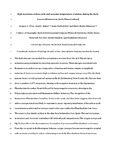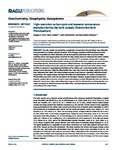High-resolution carbon cycle and seawater temperature evolution during the Early Jurassic (Sinemurian–Early Pliensbachian)
| dc.contributor.author | Watanabe, Sayaka | |
| dc.contributor.author | Baker, SJ | |
| dc.contributor.author | Vandevelde, J | |
| dc.contributor.author | Clémence, M-E | |
| dc.date.accessioned | 2017-01-09T13:04:29Z | |
| dc.date.available | 2017-01-09T13:04:29Z | |
| dc.date.issued | 2016-11-25 | |
| dc.identifier.issn | 1525-2027 | |
| dc.identifier.issn | 1525-2027 | |
| dc.identifier.uri | http://hdl.handle.net/10026.1/8222 | |
| dc.description.abstract |
The Early Jurassic was marked by a progressive recovery from the end-Triassic mass extinction and punctuated by recurring episodes of anoxia. These changes, associated with fluctuations in carbon isotope composition of marine carbonates, remain incompletely understood. Here we present a high-resolution carbon and oxygen isotope record for the Early Jurassic based on well-preserved marine mollusks (belemnites) from Dorset, UK. Our new data show a number of δ13C excursions, starting with a negative excursion at the Sinemurian-Pliensbachian boundary Event followed by lesser negative excursions showing in the Polymorphous, Jamesoni, and Masseanum-Valdani Subzones. The recognition of the Sinemurian-Pliensbachian boundary Event in this study and elsewhere suggests that observed carbon-isotope trends are likely to represent a supraregional perturbation of the carbon cycle. A prominent positive carbon-isotope event is also seen within the Pliensbachian Ibex Zone. This event is also clearly evident in the data from belemnites from Spain. This carbon-isotope excursion is not, however, coincident with inferred peak temperatures. The oxygen isotope and Mg/Ca data allow the determination of a number of pronounced Pliensbachian cool events. From the low point in the Brevispina Subzone, oxygen isotopes become more negative coupled with an increase in Mg/Ca values culminating in an Early Pliensbachian thermal maximum during the Davoei Zone. Taken with existing data, it appears that the Pliensbachian is characterized by two major warmings, first within the Davoei Zone followed by warming beginning in the latest Pliensbachian and peaking in the Early Toarcian. | |
| dc.format.extent | 3917-3928 | |
| dc.language | en | |
| dc.language.iso | en | |
| dc.publisher | American Geophysical Union (AGU) | |
| dc.title | High-resolution carbon cycle and seawater temperature evolution during the Early Jurassic (Sinemurian–Early Pliensbachian) | |
| dc.type | journal-article | |
| dc.type | Journal Article | |
| plymouth.author-url | https://www.webofscience.com/api/gateway?GWVersion=2&SrcApp=PARTNER_APP&SrcAuth=LinksAMR&KeyUT=WOS:000388694600006&DestLinkType=FullRecord&DestApp=ALL_WOS&UsrCustomerID=11bb513d99f797142bcfeffcc58ea008 | |
| plymouth.issue | 10 | |
| plymouth.volume | 17 | |
| plymouth.publication-status | Published | |
| plymouth.journal | Geochemistry Geophysics Geosystems | |
| dc.identifier.doi | 10.1002/2016GC006541 | |
| plymouth.organisational-group | /Plymouth | |
| plymouth.organisational-group | /Plymouth/Faculty of Science and Engineering | |
| plymouth.organisational-group | /Plymouth/Faculty of Science and Engineering/School of Geography, Earth and Environmental Sciences | |
| plymouth.organisational-group | /Plymouth/REF 2021 Researchers by UoA | |
| plymouth.organisational-group | /Plymouth/REF 2021 Researchers by UoA/UoA07 Earth Systems and Environmental Sciences | |
| plymouth.organisational-group | /Plymouth/Research Groups | |
| plymouth.organisational-group | /Plymouth/Research Groups/Marine Institute | |
| plymouth.organisational-group | /Plymouth/Users by role | |
| plymouth.organisational-group | /Plymouth/Users by role/Academics | |
| plymouth.organisational-group | /Plymouth/Users by role/Researchers in ResearchFish submission | |
| dcterms.dateAccepted | 2016-09-21 | |
| dc.identifier.eissn | 1525-2027 | |
| dc.rights.embargoperiod | No embargo | |
| rioxxterms.versionofrecord | 10.1002/2016GC006541 | |
| rioxxterms.licenseref.uri | http://www.rioxx.net/licenses/all-rights-reserved | |
| rioxxterms.licenseref.startdate | 2016-11-25 | |
| rioxxterms.type | Journal Article/Review | |
| plymouth.funder | Carbonate clumped-isotopic constraints on marine temperatures during the Cretaceous::NERC |



